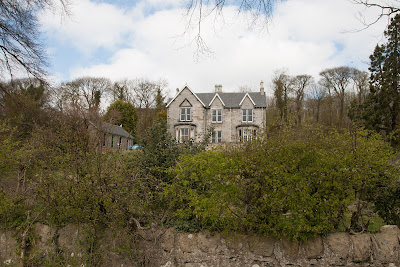But this walk is one of the few that I did, west of that line, before I made that decision, and I'm glad I did because it was a lovely walk with lots of history. For the purpose of this blog, I have used a mixture of photographs from two visits to the town, the second one being in June 2019 - hence the more verdant greenery!
I parked in Burntisland, a town which is significant in Covenanting history.
 |
| East Port Gates, Burntisland. NT2385 |
Following Hackston's execution in 1680, his disembowelled body was taken to four places to be displayed. One of those four places was the East Port at Burntisland, where there used to be an arch marking the eastern entrance to the town. It was from this archway that part of David Hackston's body was hung, no doubt as a warning to other 'rebels'. His grave is at Cupar, although I am not sure which part of him is actually buried there!
I walked up the High Street to the former site of the tollbooth.
 |
| Site of former Burntisland Tollbooth. NT2385 |
The tollbooth was demolished in 1843.
I followed the Fife Coast Path to the 16th Century Rossend Castle, which is now the offices of architects Robert Hurd & Partners. I wouldn't mind working in an office like that!
 |
| Rossend Castle. NT2285 |
I got a little lost finding my way through the park and across the railway line, but eventually found the path and walked parallel to the railway line virtually all the way to Aberdour.
 |
| Fife Coast path near Kirkton, NT2286. |
 |
| Spring on Fife Coast Path. NT2185 |
 |
| Waterfall on Fife Coast Path. NT2185 |
 |
| The Heughs, near Aberdour. NT2085 |
I had raced up the A921 as it is not pleasant walking and, feeling rather puffed out from my exertion, I quickly crossed the road to join a welcome footpath at the chevron. I now entered NT1986, but only briefly and despite it being dominated by the rather attractive name of Humbie, I somehow managed not to take a photograph in this gridsquare.
As I walked north-east and upwards, I gained some good views of Edinburgh and across the Forth and, much closer, of my destination, The Binn. The airshaft on the bottom left of the bottom photograph is to ventilate a disused mine.
 |
| Edinburgh and Arthur's Seat from NT2086 |
 |
| The Binn from NT2086 |
 |
| Burntisland and Inchkeith. NT2086 |
 |
| Torry Hill. NT2086 |
 |
| T-junction at A909. Road to Dunearn with Dunearn hill fort in background - and, noticeably, logs for sale! NT2087 |
Dunearn House provided a subject for my next gridsquare, whilst some curious horses came to say hello.
 |
| Dunearn House. NT2187 |
 |
| Horses at Dunearn. NT2187 |
 |
| Orrock Hill. NT2288 from NT2287 |
 |
| Road to Orrock. NT2287 |
I turned off right towards Craigkelly Transmitting Station Mast, a local landmark, though few perhaps know its correct name.
 |
| Craigkelly Transmitting Station on The Binn. NT2387 |
 |
| Burntisland Shale Oil Works. NT2487 |
During its heyday, however, a village was created to house the oil work employees. This was known as Binnend and was divided into two parts - High Binn and Low Binn. At the 1891 Census, the High Binn had a population of 564, crammed in to 95 houses (mainly of two rooms each) and the Low Binn had a population of 192 in 33 houses. The High Binn had its own school, Free Church Mission Hall and football pitch.
When the oil work employees were paid off in 1893, the populations began to dwindle. There was a brief revival during the First World War when troops and dockyard workers occupied the houses and when the aluminium works and the shipyard opened in Burntisland around the end of that war, the village provided good low cost homes for a number of the incoming workers.
Between the two wars, however, the decline in the permanent population continued. Many of the houses then were developed into holiday homes and old postcards. The school closed around 1931, but, despite the lack of basic facilities such as piped water, gas, electricity and sanitation, some families insisted on remaining in the village.
Sadly, by 1952 only two couples remained, the Hoods and the McLarens. The last resident to leave in 1954 was 74 year old George Hood.
Today, people in Burntisland still remember the Binn village.
I knew none of this story as I happened upon these poignant ruins.
 |
| These four photos show the village as it is today. NT2487 |
I sat on a boulder neat the village with my lunch feeling really chuffed to have come across such unexpected history on my walk. I do love it when that happens. I love having some homework to have to go and research.
I descended down the hill via a well-used footpath.
 |
| Footpath on The Binn. NT2487 |
 |
| Footpath on The Binn. NT2486 |
' An enclave of arable and pasture land on the S E side of The Binn granted by Capt [Captain] Watson, to 3 Widows of the name of Boswell, Watson and Orrock, there is a house in which the Widows live in Burntisland.'
(OS Name Book OS1/13/135/1/50)
 |
| Widow's Land, on The Binn, Burntisland. NT2386 |
I followed my nose now back to my car, turning frequently to look back at The Binn with its hidden lost village. What a wealth of stories that place must hold!
 |
| The Binn and Burntisland. NT2385 |
Number of new gridsquares: 13
Number of miles walked: 8.1
Walk worth repeating: yes, and include Orrock Hill
Highlights: Burntisland town, Binnend lost village






No comments:
Post a Comment